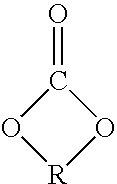Melt spun TPU fibers and process
a technology of tpu fibers and tpu fibers, which is applied in the direction of tpu spinning methods, monocomponent polyurethane artificial filaments, weaving, etc., can solve the problems of fiber breakage, production loss, and high production cost, and achieve the effect of less pressure buildup
- Summary
- Abstract
- Description
- Claims
- Application Information
AI Technical Summary
Benefits of technology
Problems solved by technology
Method used
Image
Examples
example 1
[0047]Polyether polyol PTMEG of molecular weight 2000 Daltons is charged into a heated (90° C.) and agitated tank blended with based on 100 parts by weight of the final polymer weight, with 0.3 parts by weight antioxidant and 0.3 parts by weight UV stabilizer. A second preheated tank was charged with the chain extender, 1,4-butanediol, and kept at 50° C. A third preheated agitated tank contained 4,4′-methylenebisphenylisocyanate (MDI). The ingredients of the three tanks were metered accurately into the throat of a 40 mm co-rotating twin-screw extruder reactor made by Werner & Pfleiderer Corp., Ramsay, N.J. The extruder had 11 barrel sections which were heated between 190° C. to 205° C. The end of the extruder was coupled to an underwater pelletizer after a six hole die equipped with screen packs. The following formulation was run continuously by metering 25.07 parts by weight of MDI, 5.82 parts by weight of 1,-4-butanediol and 68.5 parts by weight of polyol (PTMEG). Extruder through...
example 3
[0050]This Example is presented to show that the polyester crosslinking agent gives much less spin pack pressure buildup than the polyether crosslinking agent used in Example 2.
[0051]The TPU polymer, the melt spinning equipment and conditions were as described above in Example 2. The only difference was the crosslinking agent used. In this Example, 14.0 weight percent of a polyester crosslinking agent was used. The polyester crosslinking agent used was Diprane® 5128 from Hyperlast Company which has a number average molecular weight of 2500.
[0052]The fiber produced was 20 denier and at the same speed as in Example 1 (480 meters per minute).
[0053]The spin pack pressure force was measured during the run. FIG. 1 shows a graph of the pressure buildup during the run. The data show the spin pack pressure force at the start of the run was about 15 Kg / cm2. After about 8 hours, the spin pack pressure increased to 20 Kg / cm2. The run was continued for a total of 110 hours and the spin pack pres...
example 4
[0060]This Example is presented to show that a polyester crosslinker of neopentyl glycol adipate, which has a branched glycol component (neopentyl glycol), gives long melt spinning run times with no fiber breakage.
[0061]The TPU polymer of Example 1 was used and melt spun fibers (20 denier) were made on a melt spinning fiber pilot line smaller than that used in Examples 2 and 3. The polyester crosslinking agent used was Diprane 5253 (Hyperlast Company) which is a neopentyl glycol adipate intermediate reacted with MDI to form a pre-polymer having a number average molecular weight (Mn) of 2500. During the melt spinning, 14.0 weight percent of the polyester crosslinking agent was added to the TPU polymer.
[0062]Melt spinning was conducted for 100 hours with no fiber breakage. The run was terminated due to lack of further material.
PUM
| Property | Measurement | Unit |
|---|---|---|
| average molecular weight | aaaaa | aaaaa |
| weight average molecular weight | aaaaa | aaaaa |
| molecular weight | aaaaa | aaaaa |
Abstract
Description
Claims
Application Information
 Login to View More
Login to View More - R&D
- Intellectual Property
- Life Sciences
- Materials
- Tech Scout
- Unparalleled Data Quality
- Higher Quality Content
- 60% Fewer Hallucinations
Browse by: Latest US Patents, China's latest patents, Technical Efficacy Thesaurus, Application Domain, Technology Topic, Popular Technical Reports.
© 2025 PatSnap. All rights reserved.Legal|Privacy policy|Modern Slavery Act Transparency Statement|Sitemap|About US| Contact US: help@patsnap.com


